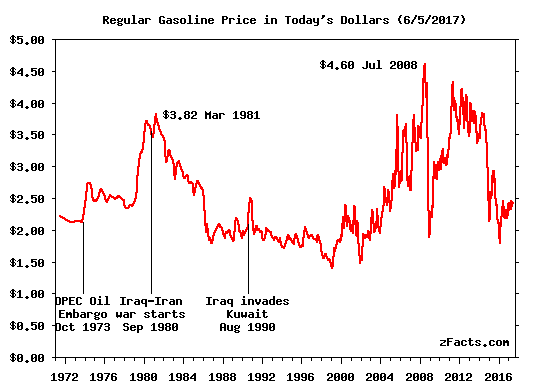The graph above shows when the Saudi’s killed OPEC at the end of 1985, and the consequences of high oil prices combined with massive recession in 2008. But first, what or who controls the price of gasoline at your local pump?
Everyone likes to blame the president at the time, or Exxon. But in reality it’s not determined in the US. There is a world price of oil, determined by the world’s supply of and demand for oil. The average price of US regular (in 2012 $) is almost exactly the world price of oil plus $1.00/gallon. How is that?
A barrel of oil is 42 US gallons. So say the world price is $84/barrel. Divide that by 42 to get the price of oil per gallon — $2 in this example. Then the price at the pump will be right about $3.00/gallon in 2012 dollars. Slightly more, in today’s dollars. You can see the proof of this here.
Why is OPEC letting the price collapse? — Some history:
In 1980, the Saudis told OPEC they were setting the price too high, but they pushed it on up to $3.68 (see graph). That brought down the world price of oil by bringing in North-Sea and Alaskan oil. The Saudis were forced to cut their production to keep the price up as much as they could. But finally, with most of their capacity idle, they got really pissed off and stole the market from the rest of OPEC, tanking the price, but regaining their market share. That was at the end of 1985. America cheered, but Bush I (then V.P.) went to Saudi Arabia to try to talk them out of this — the price drop hurt big US oil just like it hurt the rest of OPEC. This explains why OPEC can’t coordinate to keep the price up. They all want a free-ride from the Saudis. Last time the Saudis cooperated, just to save OPEC, but they got no help from the others and lost their shirts. This time, their not going to play that role and the rest of them still won’t cooperate.Fighting green energy and fracking
There’s one more reason for the price collapse. The Saudis are still smart. They know that too high a price for too long, greatly encourages alternatives to their oil supplies. Last time that was North-Sea and Alaskan oil. This time its tar sands, fracking and just maybe green energy (although that’s still every little competition). Private investment in more fragile that OPEC’s state investments, so they know they may be able to force some out of business, or at least greatly disrupt investment in OPEC alternatives. Data is from DOE’s weekly survey.(1)
References



 Ripped Apart
Ripped Apart


This is headache inducing and lacks facts. This is opinion twisted into graph form.
If climate change were an actual existential threat, then the greatest producers of CO2 (China, India) would not be exempt until 2030 from the Paris Accords, and China would not be building 200-300 coal-fired power plants around the world that will be operational for 50-60 years. The middle class in America must be brought to HEEL!
Thanks for the enlightenment! 🙂